| | Introduction | Land use and management practices | Controlling severe erosion | Summary
Introduction
Soil loss due to water erosion reduces crop yields. Managing your soil and water resources is the best way to prevent soil from being washed away. This publication describes cost-effective ways to maintain successful crop production while protecting soil and water quality.
Snowmelt and rainfall are the driving forces for water erosion on the prairies. Bare soils are very vulnerable to erosion. Steep slopes and long, uninterrupted slopes are especially prone to water erosion. Silty soils, soils low in organic matter, and soils with an impermeable subsoil layer are also more susceptible to water erosion.
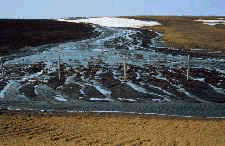
Bare soils are very vulnerable to erosion.
Plant cover - either growing plants or crop residue - protects soil from the erosive power of flowing water and rain drop impact. Conservation farming methods maintain a protective cover on the soil. These land use and management practices can be adapted to fit the needs of any farm operation. Some areas of Alberta suffer from severe water erosion. In these areas, special measures may be needed to control erosion.
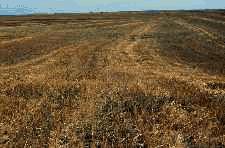
A crop residue cover protects the soil.
Research shows that soil erosion substantially lowers crop yields.
Land Use and Management Practices
Select appropriate land use
Farm management decisions should consider the potential for erosion under different practices, especially on land that is marginal for annual crop production. Areas at high risk for erosion due to steep slopes or erodible soils may be better suited for forage production or grazing. Steeply sloped lands under cultivation can be converted to permanent cover to minimize erosion. Wooded areas with poor soils and steep slopes can be left in their natural state and managed profitably as woodlots. Alternative land uses can conserve the soil and have environmental benefits, while remaining profitable to the farm operation.
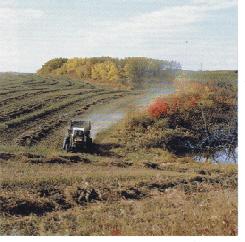 | 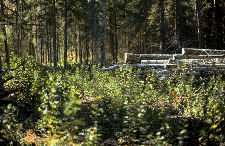 |
| Steeply sloped land can be used for forage production. | Wooded areas with poor soils and steep slopes can be managed as woodlots. |
Maintain organic matter
Soil organic matter is very important for good crop production and for reducing soil erosion. Organic matter is made up of dead plant material. During decomposition, this material releases nutrients for plants. Organic matter also improves soil structure and tilth. Organic matter and micro-organisms cement individual soil particles into larger aggregates. Soils high in organic matter have large, stable aggregates which resist erosion. A soil with stable aggregates also has more large pore spaces to hold water. With this increased moisture-holding ability, there is less ponding in fields, and less runoff and erosion.
To maintain soil quality and fertility, new additions of plant material must equal the rate of organic matter decomposition and nutrient use by plants. Conventional tillage and fallowing practices increase soil temperature and also mix and aerate the soil, causing faster organic matter decomposition. The result has been a long-term decline in soil organic matter on the prairies.
Returning crop residue to the soil helps to replace organic matter and plant nutrients. Rotations which include forages return more residues to the soil and increase fertility. Manure applications and legume plowdown are also good sources of organic matter and nutrients.
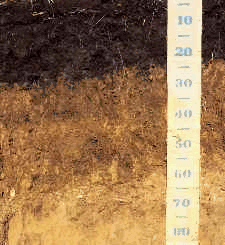
Soils high in organic matter are better able to resist erosion.
Maintain crop residue cover
One of the best ways to reduce erosion is to protect the soil surface with a cover of growing plants or crop residue. Surface cover cushions the impact of rain drops so soil particles are not as easily dislodged and moved. It also slows the flow of water, giving the soil time to absorb more water and thereby reducing runoff and erosion. An Alberta research study has shown that any increase in infiltration is directly related to a decrease in runoff. As well, crop residue traps snow and reduces evaporation for higher soil moisture which can improve crop yields, especially in a dry year.
Standing stubble and evenly spread straw and chaff protect the soil during spring runoff. Tillage should be kept to a minimum because it reduces the crop residue cover. Conservation tillage systems that leave most of the crop residue on the surface will reduce erosion and may have other benefits, such as lower equipment operating costs and labour inputs.
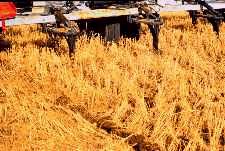
A wide blade cultivator manitains a good crop residue cover.
Reduce tillage
Conventional tillage buries the protective crop residue cover and disturbs the soil. The loose soil particles are easily detached by rain drops and running water. These factors lead to increased runoff and erosion.
Alberta research shows that switching to reduced or zero tillage systems is needed to protect soils on steeper and longer slopes from erosion. Reduced and minimum tillage systems leave a good crop residue cover to prevent erosion and conserve soil moisture. These systems also save time and energy, and costs are usually similar to or lower than those for conventional tillage systems.
Tillage is reduced by replacing some tillage operations for weed control with herbicide applications, or by using alternative tillage equipment that helps maintain a good residue cover (see table).
Residue management is important in all conservation tillage systems. Straw and chaff must be spread evenly at harvest to avoid or reduce such problems as: plugging during subsequent operations; poor seed germination; disease, weed and insect infestations; and nutrient tie-up.
Use zero tillage or direct seeding
Zero tillage systems minimize soil disturbance to maintain as much crop residue cover as possible to conserve soil moisture and prevent erosion. Long-term zero tillage also increases soil organic matter and improves soil quality and fertility.
Direct seeding also aims to conserve both soil moisture and soil. It differs from zero tillage in that some tillage options remain open. Minimal disturbance tillage operations (which leave the stubble standing) are sometimes used to apply fertilizer or incorporate herbicides or manure. A high percentage of crop residue remains on the surface to protect against erosion.
In both zero tillage and direct seeding systems, straw and chaff should be spread evenly across the entire width of the cut during combining. Harrowing may be needed to achieve uniform distribution, especially for heavy crop residues. The crop is seeded into the previous crop's stubble with minimal soil disturbance. Fertilizer is usually banded in a row near the seed. Herbicide applications replace tillage to control weeds. Management practices such as crop and herbicide rotations can be used to reduce weed problems.
Direct seeding and zero tillage systems save time and may have lower operating costs than conventional tillage systems. Although herbicide costs may increase, tillage-related costs decrease. Improvements in herbicides and sprayers, and the availability of seed drills able to operate in crop residues have made it easier to switch to zero tillage and direct seeding.
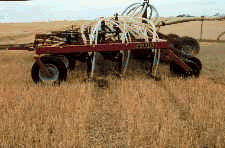
Direct seeding drills can seed into standing stubble.
Use conservation fallow
The long-term use of conventional fallow has caused serious soil degradation problems. In conventional fallow, weed control and seedbed preparation are done by tillage. Tillage buries crop residues, leaving the soil at risk from erosion for a long period.
While the soil is fallow, organic matter decomposes. This releases nitrogen and other nutrients for the following crop. However, with no residue input from crops during the fallow period, the amount of organic matter declines. The resulting poorer soil structure lowers the soil's ability to absorb water and increases runoff and erosion.
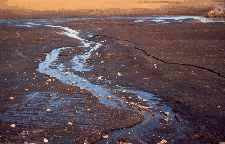
Fallow fields with no residue cover are very erosion prone.
If summerfallow is necessary, maintain a crop residue cover by minimizing surface disturbance. Herbicides can be used to control weeds, and one spray operation can replace two tillage operations. Wide blade cultivators or rod weeders minimize residue disturbance. Reducing tillage will protect the soil, conserve soil moisture and may also lower equipment operating costs and labour needs.
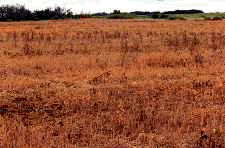
Conservation fallow maintains a crop residue cover to protect the soil.
Grow forages and use crop rotations
Forage crops are a component in many conservation farming systems. Forages can be grown on poorer soils or steep slopes not suitable for other crops, or used in rotations to build organic matter or break disease cycles. Forage cover protects the soil from erosion, and the fibrous roots hold the soil in place. As a perennial crop or plowdown, forages add organic matter and improve soil quality and structure. Improved soil structure allows the soil to absorb more water which reduces runoff and erosion.
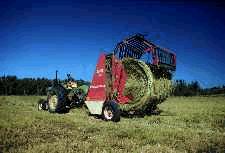 | 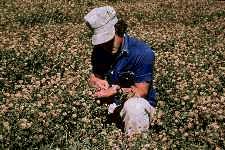 |
| Forage crops protect and improve the soil. | Legumes protect the soil and add nitrogen and organic matter. |
Crop rotations for erosion control alternate forages with cereals and oilseeds or legumes. A well-planned rotation will improve soil quality and reduce erosion. Legumes in the rotation also add nitrogen and improve soil fertility. In drier areas, forages are harder to establish and may deplete moisture in a short-term rotation. An alternative annual crop such as a legume can be grown in these areas, or the forages can be maintained as a longer term crop.
Use direct seeding for pasture conversion
Direct seeding is a good option for converting hay or pasture land to annual crop production. It produces crop yields similar to those from conventionally plowed systems, and also prevents soil erosion and moisture loss. In conventional systems, intense operations such as plowing, heavy discing and cultivations are used. They are costly and time consuming, and expose soil to erosion.
Annual crops such as barley, oats and peas can be direct seeded into pasture sod after the pasture vegetation has been killed by a herbicide, usually glyphosate (Roundup). Fall spraying is usually preferred over spring spraying for better annual crop yields, weed/pasture plant control, and moisture conservation.
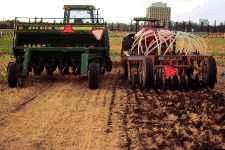
Both a disc drill (left) and an air drill (right) work well for direct seeding into sod.
Controlling Severe Erosion
The following measures control gullies and other severe erosion problems. For severe erosion, it is a good idea to get technical advice to find the best solution for your situation.
Grassed waterways
Gully erosion can often be controlled with a grassed waterway. A grassed waterway is a wide, shallow grassed channel that can carry a large volume of water quickly down a steep slope. It can be crossed by lifting tillage equipment.
Grassed waterways on agricultural land need to be able to carry peak runoff events from snowmelt and rainstorms (up to one cubic metre of water per second). The size of the waterway depends on the size of the area to be drained. A typical grassed waterway cross-section is saucer-shaped with a nearly flat-bottomed channel, a bottom width of 3 m and channel depth of at least 30 cm (see figure). Side slopes usually rise about 1 m for every 10 m horizontal distance. The waterway should follow the natural drainage path if possible.
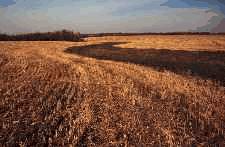 | 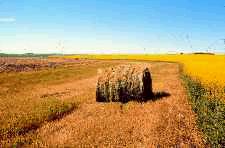 |
| Grassed waterways are shallow and easy to cross. | Some landowners produce hay on their waterways. |
Cross-section of a typical grassed waterway.
The grass cover must be well established to handle high flows without erosion. A fast-growing cover crop, such as oats, provides initial, temporary protection for the waterway until the grass cover is established. Steeper portions of the waterway which are very susceptible to erosion can be protected by bio-degradable erosion control mats until the grass is established. Commercially available mats are made from straw, jute or aspen wood shavings.
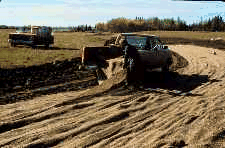
A newly constructed waterway may need protection until the grass cover is established.
A well-built and maintained grassed waterway is very durable and erosion-resistant. The waterway should be mowed regularly, and weeds and brush must be controlled for the waterway to remain effective.
Lined channels
Lined channels are a means of dropping water to lower elevations along steep parts of a waterway. Those portions of the waterway are precisely shaped and carefully lined with heavy-duty erosion control matting, a type of geotextile product. The lining is covered with a layer of soil and seeded to grass. The resulting channel is highly resistant to erosion. Lined channels are appropriate for waterways that only carry water occasionally and have slopes up to 10 per cent. Companies that sell geotextile products provide detailed information on installation of their products.
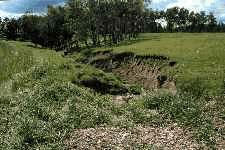 | 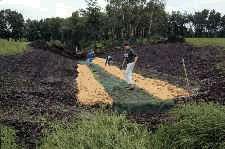 | 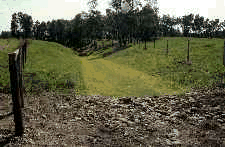 |
| An eroded gully. | Installing erosion control matting to create a lined channel. | After seeding the lined channel. |
Drop structures
Drop structures are constructed along waterways to drop water to lower elevations without causing erosion. They are constructed of concrete, wood, metal or rock. Drop structures are the most costly but occasionally the most appropriate form of erosion control at specific locations along a waterway.
Small, intermittent waterways entering Alberta's deep river valleys are capable of causing very large gullies. Pipe drop structures are effective and economic for controlling this kind of erosion. Concrete sewer manholes or vertical corrugated steel pipes used with smaller diameter corrugated plastic or metal pipe, can transport water safely down long, steep slopes. A crawler tractor with a blade is used to form a firm bed down the length of the gully beginning at the top. A small track hoe is used to dig and install any buried sections of pipe. Above-ground portions of installed pipe can be secured with posts made of angle iron.
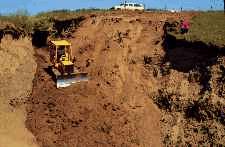
Crawler tractor forming a firm bed for a pipe drop structure.
Cross section of a pipe drop structure.
A slow release drop structure is an inexpensive and effective measure to control gully erosion. An earth berm is constructed upstream from the gully. Runoff water is held back temporarily by the berm. The water drains slowly through a small diameter plastic pipe (75 mm to 200 mm diameter) which runs under the berm and down the slope, and outlets at the bottom. A durable, high density polyethylene pipe is recommended. The small pipe can be held in place on the slope where needed with steel pins. This structure can only be used where there is an area with enough storage capacity upstream of the gully. The flooded area is fully drained within two days to prevent crop damage. In fact, the temporary backflooding benefits the crop by increasing soil moisture.
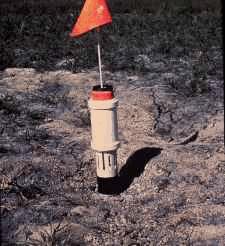
Slow release drop structure.
Inlet
Terracing
Water erosion over long, wide slopes without well-developed channels can be controlled with terracing. A channel and berm with up to 1 m difference in elevation are constructed across the slope to intercept runoff and carry it safely off the field. The material excavated to create the channel is used to build the berm. A survey is essential to find the best terrace location on the slope and to maintain proper grade for drainage. The project should be staked before construction to guide the equipment operators. Heavy-duty road construction equipment, such as a motor scraper, is needed to construct terraces.
Cross-section of one type of terrace.
Terraces are practical only when crop returns from the land are high enough to justify construction costs. Tillage and residue management options should be evaluated before considering terraces.
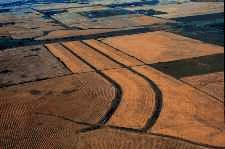
Terraces intercept runoff.
Summary
Many on-farm water erosion problems can be solved by the farm operator with minimal expense or inconvenience. Modifying tillage practices to keep crop residue on the surface can greatly reduce erosion. A crop residue cover also conserves soil moisture and improves soil tilth and fertility for better crop production. Costs for conservation tillage systems are usually similar to or lower than costs for conventional tillage systems over the long term. Preventing soil erosion helps to ensure the sustainability of the farm operation.
Grassed waterways, drop structures, lined channels or terraces are used to control more severe water erosion problems. Technical advice may be needed to implement some of these special measures.
Prepared by:
Douwe Vanderwel and Syd Abday
Source: Agdex 572-3. |
|